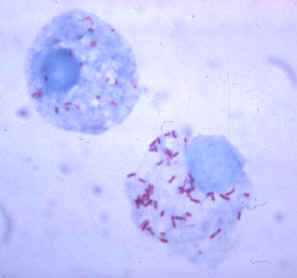- Rickettsia rickettsii
Taxobox
color = lightgrey
name = "Rickettsia rickettsii"

regnum = Bacteria
phylum =Proteobacteria
classis =Alpha Proteobacteria
ordo =Rickettsiales
familia =Rickettsiaceae
genus = "Rickettsia "
species = "R. rickettsii"
binomial = "Rickettsia rickettsii"
binomial_authority = Brumpt, 1922"Rickettsia ricketsii" is native to the
New World and causes the malady known asRocky Mountain spotted fever (RMSF). RMSF is transmitted by the bite of an infectedtick while feeding on warm-blooded animals, including humans. Man is an accidental host in the rickettsia–tick life cycle and is not required to maintain the rickettsiae in nature.Wolbach deserves the credit for the first detailed description of the
etiologic agent in 1919. He clearly recognized it as an intracellular bacterium which was seen most frequently inendothelial cell s. He was struck by the fact that in the tick, and also inmammalian cells, the microorganism was intranuclear. The nucleus was often completely filled with minute particles and often was distended. Although Wolbach recognized its similarity to the agent oftyphus andtsutsugamushi fever (scrub typhus), he did not regard the designation 'rickettsia' as appropriate. He proposed the name "Dermacentroxenus rickettsi".Emile Brumpt felt that the etiologic agent of RMSF, despite some uncertainty about its properties, belonged in the genus Rickettsia and in 1922 proposed the name "Rickettsia rickettsii".References
Weiss K., The Role of Rickettsioses in History. 2 - 14. In: Walker, D.H., Biology of Rickettsial Diseases, Volume I., 1988. CRC Press Inc, Boca Raton, Florida.
Weiss, E., History of Rickettsiology. 15 - 32. In: Walker, D.H., Biology of Rickettsial Diseases, Volume I., 1988. CRC Press Inc, Boca Raton, Florida.
External links
* [http://patric.vbi.vt.edu/genome/overview.php?genomeId=113 "Rickettsia rickettsii"] (from [http://patric.vbi.vt.edu/ PATRIC] , the PathoSystems Resource Integration Center, a [http://www3.niaid.nih.gov/ NIAID] Bioinformatics Resource Center)
Wikimedia Foundation. 2010.
